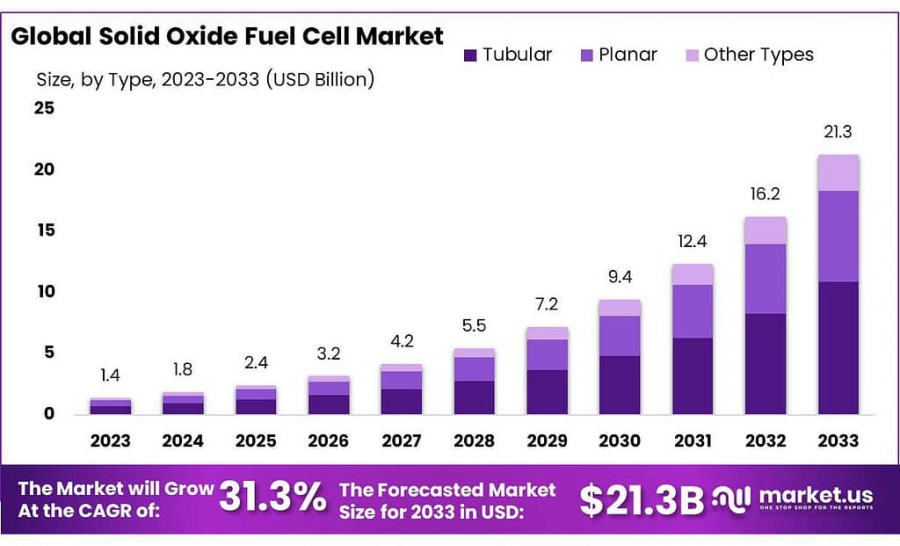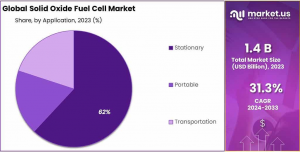
Solid Oxide Fuel Cells Market To Surpass USD 21.3 Bn by 2033 | Steady Growth with a 31.3% CAGR
The Solid Oxide Fuel Cells Market size is expected to be worth around USD 21.3 Bn by 2033, from USD 1.4 Bn in 2023, at a CAGR of 31.3% from 2023 to 2033.
NEW YORK, NY, UNITED STATES, January 27, 2025 /EINPresswire.com/ -- The global Solid Oxide Fuel Cells (SOFC) Market is experiencing substantial growth, driven by the increasing demand for clean and sustainable energy solutions. Solid oxide fuel cells are a type of fuel cell that generates electricity through electrochemical reactions, typically using hydrogen or other fuels such as natural gas. Their high efficiency and ability to operate on a variety of fuels make them a promising technology for both stationary and portable applications. As industries and governments around the world strive to meet ambitious decarbonization targets, SOFCs are gaining traction as a viable solution for reducing carbon emissions while ensuring reliable power generation.
Key players in the market are focusing on advancing the technology’s efficiency, durability, and scalability to meet the growing demand for clean energy solutions. Companies are investing heavily in research and development (R&D) to improve fuel cell performance, reduce costs, and expand their applications. Moreover, SOFCs are finding increasing applications in various sectors, including automotive, power generation, and residential energy systems. The rising integration of renewable energy sources, such as wind and solar, with SOFC technology, is also creating new market opportunities, as these systems can provide continuous power supply when intermittent renewable sources are unavailable.
Several driving factors are contributing to the growth of the SOFC market. First and foremost, the global shift towards sustainable energy solutions is fueling the demand for alternative power generation technologies. With increasing concerns over air pollution, climate change, and reliance on fossil fuels, SOFCs present a promising alternative due to their ability to produce clean electricity with minimal environmental impact. Additionally, their high efficiency compared to traditional combustion-based power generation systems makes them an attractive option for reducing energy consumption and costs in various industries. Governments and regulatory bodies are also providing substantial incentives for clean energy technologies, further driving the adoption of SOFCs.
Another key factor driving market growth is the rising demand for distributed power generation. SOFCs offer the flexibility to be deployed in decentralized energy systems, providing power at the point of consumption, thus reducing transmission losses and enhancing grid reliability. This is particularly advantageous for remote locations and areas with limited access to centralized energy infrastructure. Furthermore, as the technology continues to mature, the cost of SOFC systems is expected to decrease, making them more accessible to a wider range of industries and applications.
Looking ahead, the future growth opportunities for the global SOFC market are promising. The continued development of high-performance materials, such as advanced ceramic components and electrochemical catalysts, is expected to enhance the efficiency and longevity of SOFC systems. Moreover, the increasing adoption of hybrid systems, which combine SOFCs with other renewable energy technologies like solar or wind, will further broaden the scope of applications and improve overall energy management.
The ongoing efforts to reduce production costs, coupled with the anticipated rise in government and private sector investments in clean energy infrastructure, will likely result in an accelerated adoption of SOFC technology across various regions. As global energy policies continue to evolve, the SOFC market is poised for sustained growth, with the potential to play a key role in the global transition to a low-carbon economy.
Tap into Market Opportunities and Stay Ahead of Competitors – Get Your Sample Report Now: https://market.us/report/solid-oxide-fuel-cells-market/free-sample/
Key Takeaways
• Market Growth Projection: The Solid Oxide Fuel Cells Market is poised to grow from USD 1.4 billion in 2023 to USD 21.3 billion by 2033, with a CAGR of 31.3% during the forecast period.
• Type Analysis: Planar SOFCs hold a dominant 61% market share in 2023 due to their efficiency and compact design, while tubular SOFCs, though less common, are favored in high-temperature applications for their robustness.
• Application Insights: The stationary segment leads with 62% of the market revenue in 2023, valued for efficient and clean heat and electricity generation; growth in the transportation sector is driven by partnerships between SOFC vendors and transportation suppliers, expanding SOFC applications.
Solid Oxide Fuel Cells Top Trends
1. Hybrid System Integration: The integration of SOFCs with complementary technologies like gas turbines and microturbines is enhancing efficiency, flexibility, and dependability. These hybrid systems are designed to maximize energy output and performance, making them more effective in a variety of settings.
2. Decentralized Energy Solutions: There's a growing shift towards decentralized energy solutions, with SOFCs playing a crucial role. Their high efficiency and low emissions make them ideal for distributed power generation in residential, commercial, and industrial settings.
3. Technological Advancements and Innovation: Continuous improvements in SOFC technology are leading to more efficient and versatile systems. Innovations are focused on creating compact, reliable SOFC solutions that can be integrated into existing infrastructure and operate with various fuels including natural gas, biogas, and hydrogen.
4. Increased Focus on Portable Applications: The portable segment of SOFCs is witnessing significant growth due to rising electricity demand in off-grid locations. Continuous R&D is enhancing the viability of SOFCs for portable use, particularly in areas where clean energy generation systems are needed.
5. Growing Dominance in Stationary Applications: SOFC technology continues to lead in stationary applications, favored for high electrical and combined heat and power efficiency. The technology's adoption is particularly strong in sectors that require reliable, clean power generation such as data centers and commercial buildings.
Key Market Segments
Type Analysis
In 2023, Planar SOFCs dominated the market with over 61% share, prized for their efficiency and compactness. This design aligns well with industries that prioritize reliable and adaptable power solutions. Conversely, Tubular SOFCs, though less prevalent, are valued for their robustness and high-temperature performance. Their construction facilitates easier scalability and maintenance, making them suitable for specific uses where their unique attributes are required.
Application Analysis
The stationary segment led the market in 2023, capturing 62% of the revenue. These systems are primarily assessed based on electrical efficiency, overall cogeneration efficiency, and durability. Significant investments in SOFC R&D by countries like France and the UK aim to enhance applications in electric vehicles and other transport means, promising growth for this segment.
The collaboration between SOFC manufacturers and transportation sector stakeholders is fostering the development of transport applications using SOFC technology. A notable partnership in 2020 between Ceres and AVL aimed to accelerate SOFC advancements in both stationary and transport sectors, leveraging combined expertise and intellectual property to innovate and deliver new.
Directly Purchase a copy of the report - Save as Much as 30%! https://market.us/purchase-report/?report_id=78429
Key Market Segments List
By Type
• Tubular
• Planar
• Other Types
By Application
• Transportation
• Portable
• Stationary
Regional Analysis
In 2023, APAC led the global market with the highest revenue share of 46.8%, expected to maintain a significant capacity demand in the coming years. Japan serves as a major hub, with the bulk of SOFCs deployed in stationary applications. The region is poised for the fastest growth during the forecast period due to robust industrial expansion and energy needs.
Malaysia, Singapore, and India are enhancing their regulatory frameworks to foster growth in the alternative energy sector. Research institutes and government initiatives in India and Thailand are evaluating the operational viability and market demand for solid oxide fuel cells, which are anticipated to propel the market growth further.
In North America, SOFCs are predominantly used in stationary sectors, with the market set to see rapid growth. The United States has witnessed substantial market expansion, supported by strong governmental backing and strategic market focus.
Germany stands out in the European market for its high adoption of SOFCs, driven by well-structured energy policies and government-set targets. These policies are instrumental in guiding the technological advancements and deployment of solid oxide fuel cells in the region.
Regulations On the Solid Oxide Fuel Cells Market
• Environmental Regulations and Emissions Standards: Many countries have stringent emissions regulations that encourage the use of clean technologies like SOFCs. SOFCs, which generate electricity with minimal emissions, comply with these standards, making them attractive for use in power generation sectors aiming to reduce their carbon footprint and meet environmental targets.
• Government Incentives and Subsidies: Various governments offer financial incentives, including subsidies and tax credits, to encourage the adoption of SOFCs. These incentives aim to lower the initial cost of implementing clean energy technologies, promoting a faster transition to sustainable power generation in commercial, industrial, and residential sectors.
• Hydrogen Integration and Fuel Regulations: As SOFCs can operate on hydrogen and natural gas, regulatory bodies in many regions are developing standards for hydrogen production, storage, and distribution. These regulations ensure that the hydrogen used in SOFC systems is produced sustainably and meets safety and purity standards for optimal fuel cell performance.
• Energy Efficiency Standards: In some regions, regulations are focused on improving energy efficiency in power generation systems. SOFCs, known for their high efficiency compared to traditional combustion-based systems, are increasingly incorporated into energy efficiency standards, making them a preferred choice for meeting both regulatory and environmental objectives.
• Certification and Testing Requirements: Before commercial deployment, SOFC systems must pass various certifications and safety tests to ensure their reliability and efficiency. Regulatory bodies require thorough testing of fuel cell stacks and components to ensure that they meet specific performance, safety, and durability criteria.
Key Players
• Bloom Energy
• Mitsubishi Power Ltd.
• Cummins Inc.
• Ceres
• General Electric
• Fuel Cell Energy Inc.
• Ningbo SOFCMAN Energy
• KYOCERA Corporation
• AVL
• NGK SPARK PLUG CO., LTD.
• Other Key Players
Conclusion
The Solid Oxide Fuel Cells (SOFC) market is poised for substantial growth, driven by the increasing demand for sustainable and efficient energy solutions. The technology's high efficiency, low emissions, and versatility make it an attractive option for both stationary and mobile applications across various industries. With ongoing advancements in materials, hybrid systems, and regulatory support, SOFCs are becoming a key player in the global shift towards cleaner energy.
As governments and businesses continue to prioritize energy sustainability, the adoption of SOFC technology is expected to accelerate, presenting significant opportunities for market expansion and innovation. The combination of technological development, favorable regulatory environments, and growing market acceptance positions SOFCs as a critical component in the transition to a low-carbon economy.
Lawrence John
Prudour
+91 91308 55334
Lawrence@prudour.com
Distribution channels: Energy Industry
Legal Disclaimer:
EIN Presswire provides this news content "as is" without warranty of any kind. We do not accept any responsibility or liability for the accuracy, content, images, videos, licenses, completeness, legality, or reliability of the information contained in this article. If you have any complaints or copyright issues related to this article, kindly contact the author above.
Submit your press release


